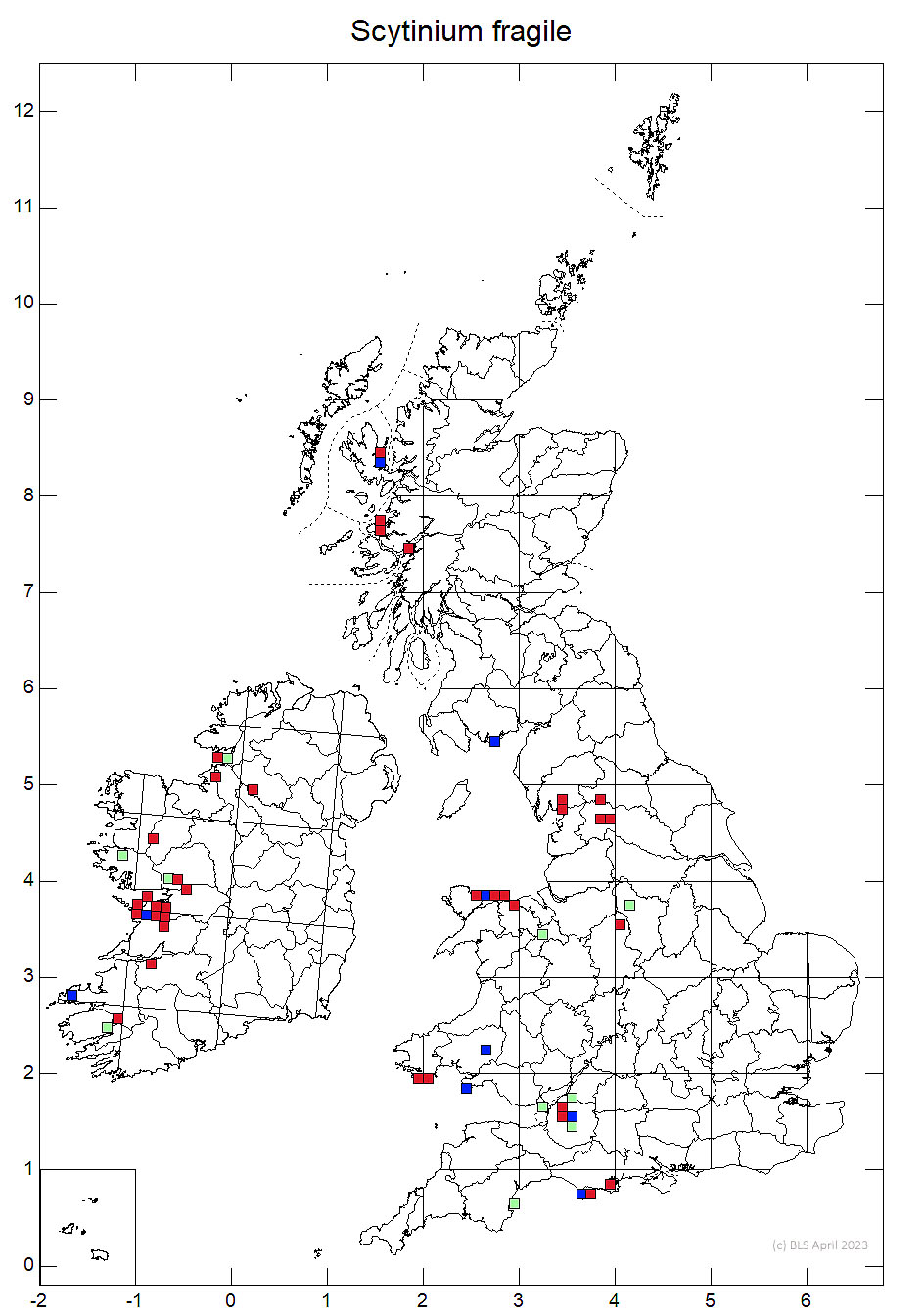A rather small (to 2cm diam) jelly lichen that occurs on carboniferous limestone in Wales forming irregular and incomplete rosettes. Being in the genus Collema it lacks a cellular cortex. The thallus also lacks longitudinal ridges but the older parts of the lobes become rugose and become covered in numerous globose isidia and with whitish pubescence around the edges of the most actively growing lobes. Apothecia are rare but are reported once from the Gower.
.jpg)
Photo: Alan Orange (scale = 1mm)
Resembles Lempholemma botryosum but that has unicellular spores. Small Leptogiums have a cellular cortex and Collema parvum lacks the whitish pubescens on the lobe tips.
On lightly shaded seepage tracks that are usually steeply inclined on Carboniferous Limestone cliffs.
In Wales it is found on Carboniferous Limestone close to the coast in both North and South Wales. Elsewhere in Britain it has recently been seen in a handful of western localities from Portland Bill in the south to Raasay in the western Scottish Highlands. In Ireland it has only been seen recently on limestone in C. Clare. Its world distribution is limited to the warmer parts of south and western Europe. Its Scottish localities are the most northerly known.
| Location | Grid Reference | Last Rec'd | Recorder | SSSI |
| Anglesey: Bwrdd Arthur, Llanddona | SH5881 | 2002 | S.P. Chambers | Yes |
| Caernarvonshire: Gt Orme's Head | SH7562784426 | 2006 | V. Giavarini | Yes |
| Denbighshire: Rhyd y Foel, Llanddulas | SH906769 | 1995 | A. Orange & R.G. Woods. | Yes |
| Glamorgan: Mewslade, Gower | SS422873 | 1997 | A. Orange | Yes |
| Glamorgan: Richard's Rock, Mewslade, Gower | SS4227987401 | 2011 | R.G. Woods & T. Wilkins | Yes |
| Glamorgan: SE-facing cliffs, Mewslade, Gower | SS4218387365 | 2011 | R.G. Woods & T. Wilkins | Yes |
| Pembroke: Lydstep Point | SS0997 | 2004 | S.P. Chambers | Yes |
| Pembroke: Stackpole | SR9720993119 | 2007 | B. Edwards | Yes |
| Pembroke: Broadhaven Cliffs, Stackpole | SR9771194340 | 2011 | R.G. Woods & T. Wilkins | Yes |
There are earlier records from Stackpole, Pembs, the Great orme, Caerns. and the Little Orme, Denbighshire the details of which have yet to be located.
The Great Orme - population consists of about 16 colonies near the lighthouse back gate in a cleft of limestone. They were overgrowing Verrucaria baldensis.
Mewslade Bay - on the west-facing limestone cliffs, seen by the BLS in 1990. Alan Orange (1997) reports a more detailed survey, locating it in four places, being mostly associated with Caloplaca cirrochroa, C. flavescens, C. granulosa and V. baldensis and provides details of associated species in 9 quadrats. Refound in two sites by Tim Wilkins and Ray Woods in 2011.
Stackpole - Bryan Edwards in his "Site Dossier and Common Standards Monitoring for Lichens:Stackpole SSSI in 2008 for the Countryside Council for Wales (CCW) notes its presence in compartments 03 back of Barafundle Bay, 04b Broadhaven Cliffs, 82 and 84 Western Arm. In August 2011 Ray Woods and Tim Wilkins relocated the population at the head of Broad Haven. It was visible on the near verical limestone rock on the west side of the lake overflow channel, visible from the wooden footbridge.
Castlemartin Ranges-Bryan Edwards in his "Site Dossier and Common Standards Monitoring for Lichens:Castlemartin Cliff and Dunes SSSI in 2008 for CCW notes a small population on north-east facing rocks in the New Quay Valley.
The spread of deeply shading shrubs, trees and climbers such as ivy may become a threat. Alien Cotoneaster species are colonising all the coastal limestone cliffs. All known sites are specially protected and action to control non native species is believed to be under way. A warming climate may benefit this species.
Edwards, B. (2008). Site Dossier & Common Standards Monitoring for Lichens: Castlemartin Cliffs and Dunes SSSI. CCW Regional Report CCW/WW/09/5.
Edwards, B. (2008). Site Dossier & Common Standards Monitoring for Lichens: Stackpole SSSI. CCW Regional Report CCW/WW/09/6.
Giavarini, V. (2007). Site Dossier for Lichen SSSI Features: Pen y Gogarth/Great Ormes Head SSSI, North Wales. Report to CCW.
Orange, A. (1997). A Baseline Survey of Rare Lichen Species in South Area. Report to CCW.
- Log in to post comments

